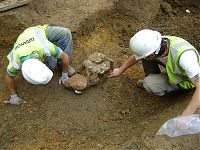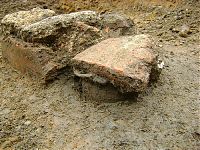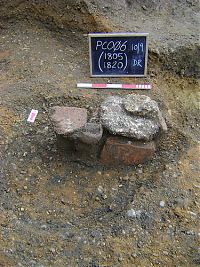Moving... Touching... Romancing Prescot Street
- By: Will Clarke |
- Sep 17, 2008
- Share
- del.icio.us

Days ago now, I found myself building up a sweat mattocking the fill of a large quarry pit Context: 1847 metres away from one of the most extraordinarily rich cremation burials I have ever encountered, which was being dug by Ruth Context: 1801. My pit in contrast seemed so dull and uninspiring – as well as a pig to dig – so it was not hard from time to time not to shift my gaze towards Ruth’s pit and see what she was unearthing next …ah a coin…another glass vessel..oh..and another…..that was until in my pit my interest was instantly raised by uncovering a fragment of opus signinum just a small piece either …this was substantial.
The vibrant pink red colouration of this distinctive mortar type is irrefutable evidence of Roman construction, and loving Roman buildings makes it, for me, one of the most appealing materials of the Roman world. From this moment onwards, fascination for Ruth’s burial left my mind, and, as it turned out, this rather innocuous looking lump of opus signinum mortar although not deriving from a building would turn out to be one of the most exciting and moving…yes…moving touching discoveries in the cemetery to date…but you have to be patient whilst I explain why. This fragment of pink mortar had been used as a capping stone to seal a box-shaped cist housing the un-urned remains of a cremation burial Context: 1805. The cist is oblong in shape around 0.52m in length, 0.38m in width, and 0.36m in height, with its long axis aligned East – West.
Ceramic tiles had been used to form the sides; these included a fragment of box flue tile to show that the material employed to construct the cist derived from demolition of a Roman baths. The remarkable preservation of the structure, coupled with the fact that only two other un-urned remains in cists are known from the Eastern cemetery made this feature an exceptional find. This was by no means the end of the story; what made this burial context truly exceptional and why it was moving…touching was that we have evidence showing at a later date the burial pit containing the cist Context: 1806 was partially reopened and enlarged Context: 1821. This was in order to accommodate the cremated remains of another individual this time interred within a ceramic vessel Context: 1820, which was sealed by placing a Roman tile on the vessel’s neck. The cremation vessel was purposefully positioned at the end of the cist on its Eastern side so close it touched….now that’s moving…romantic….call it what you like.
A votive offering in a pot Context: 1823 was also made and again purposefully positioned to nestle between the two, touching the tile covering of the cremation burial and tile wall of the cist burial. The height of the votive pot was discovered at the same depth as the cist capping stone. This shows the offering was placed in the grave when soil had been backfilled to reach the height of the cist and cremation urn covering tile. All this evidence shows that the burial location of the tile cist had been clearly marked above ground, and more significantly, may point to these two individuals being related, such as a husband and wife. With the help of Greg and Liz, umpteen bandages and lots of luck, both the cremation vessel with its tile lid and the contents of the cist were block lifted intact. This allows the possibility that laboratory analysis can identify the sex and age of the individuals inhumed and enhance the moving…touching story portrayed by these two quite unique burials.


